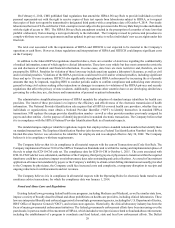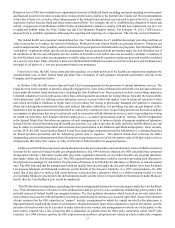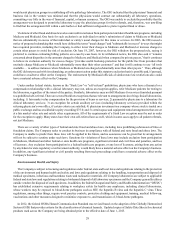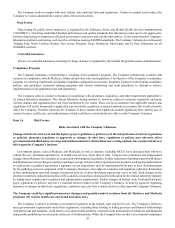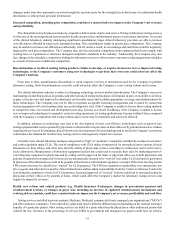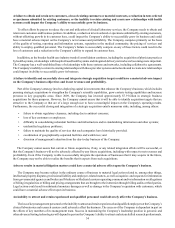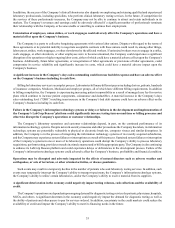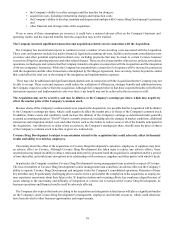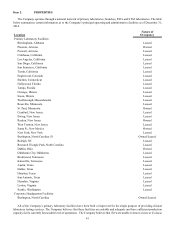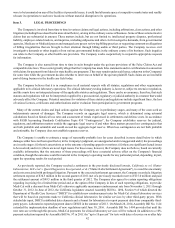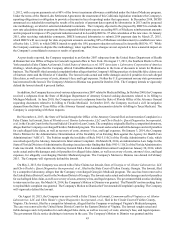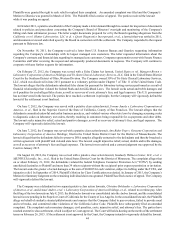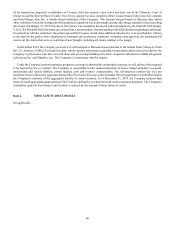LabCorp 2014 Annual Report Download - page 38
Download and view the complete annual report
Please find page 38 of the 2014 LabCorp annual report below. You can navigate through the pages in the report by either clicking on the pages listed below, or by using the keyword search tool below to find specific information within the annual report.36
Hardware and software failures, delays in the operation of computer and communications systems, the failure to implement
system enhancements or cyber security breaches may harm the Company.
The Company's success depends on the efficient and uninterrupted operation of its computer and communications systems.
A failure of the network or data gathering procedures could impede the processing of data, delivery of databases and services,
client orders and day-to-day management of the business and could result in the corruption or loss of data. While certain operations
have appropriate disaster recovery plans in place, there currently are not redundant facilities everywhere in the world to provide
IT capacity in the event of a system failure. Despite any precautions the Company may take, damage from fire, floods, hurricanes,
power loss, telecommunications failures, computer viruses, break-ins, cybersecurity breaches and similar events at our various
computer facilities could result in interruptions in the flow of data to the servers and from the servers to clients. In addition, any
failure by the computer environment to provide required data communications capacity could result in interruptions in service. In
the event of a delay in the delivery of data, the Company could be required to transfer data collection operations to an alternative
provider of server hosting services. Such a transfer could result in delays in the ability to deliver products and services to clients.
Additionally, significant delays in the planned delivery of system enhancements, improvements and inadequate performance of
the systems once they are completed could damage the Company's reputation and harm the business. Finally, long-term disruptions
in the infrastructure caused by events such as natural disasters, the outbreak of war, the escalation of hostilities, acts of terrorism
(particularly involving cities in which the Company has offices) and cybersecurity breaches could adversely affect the business.
Although the Company carries property and business interruption insurance, the coverage may not be adequate to compensate for
all losses that may occur.
Changes in reimbursement by foreign governments and foreign currency exchange fluctuations could have an adverse
impact on the Company’s business.
The Company has business and operations outside the U.S. Changes by foreign governments in reimbursement for the
Company’s services and foreign currency fluctuations could have an adverse impact on the Company’s business.
The Company's growing international operations could subject it to additional risks and expenses that could adversely
impact the business or results of operations.
The expansion of the Company's international operations exposes it to risks from failure to comply with foreign laws and
regulations that differ from those under which the Company operates in the U.S. In addition, the Company may be adversely
affected by other risks of expanded operations in foreign countries, including export controls and trade regulations, changes in tax
policies or other foreign laws, restrictions on currency repatriation, judicial systems that less strictly enforce contractual rights,
countries that provide less protection for intellectual property rights, and procedures and actions affecting approval, production,
pricing, reimbursement and marketing of products and services. Further, international operations could subject the Company to
additional expenses that the Company may not fully anticipate, including those related to enhanced time and resources necessary
to comply with foreign laws and regulations, difficulty in collecting accounts receivable and longer collection periods, and
difficulties and costs of staffing and managing foreign operations. In some countries, the Company's success will depend in part
on its ability to form relationships with local partners. The Company's inability to identify appropriate partners or reach mutually
satisfactory arrangements could adversely affect the business and operations.
Risks Associated with Company’s Acquisition of Covance
In order to fund the Covance acquisition, the Company has materially reduced its cash balance and has taken on substantial
additional indebtedness.
The Company completed the acquisition of Covance on February 19, 2015 (the "Acquisition"). To fund the consideration
to be paid to Covance stockholders pursuant to the terms of the Merger Agreement, the Company used approximately $4.3 billion
in cash and issued approximately 15.3 shares of the Company's common stock. On November 2, 2014, in connection with entering
into the Merger Agreement with Covance, the Company entered into a bridge facility commitment letter. Under the bridge facility
commitment letter, the lenders agreed to provide a $4.25 billion senior unsecured bridge term loan credit facility consisting of
$3.85 billion 364-day unsecured bridge tranche and a $400.0 million 60-day unsecured cash bridge tranche for the purpose of
financing all or a portion of the cash consideration and the fees and expenses in connection with the transactions contemplated by
the Merger Agreement. On December 19, 2014, the Company entered into a five-year term loan credit facility in the principal
amount of $1.0 billion for the purpose of financing a portion of the cash consideration and the fees and expenses in connection
with the transactions contemplated by the Merger Agreement. Pursuant to the bridge facility commitment letter, upon the Company's
entry into the term loan credit facility, the $4.25 billion bridge facility was reduced to a $3.25 billion commitment, comprising a
$2.85 billion 364-day unsecured debt bridge tranche and a $400.0 million 60-day cash bridge tranche. The $1.0 billion of term
loan commitments made under the term loan credit facility reduced the debt bridge tranche under the bridge facility dollar for


